Changyuan Yu
Timing Recovery for Non-Orthogonal Multiple Access with Asynchronous Clock
Jul 10, 2024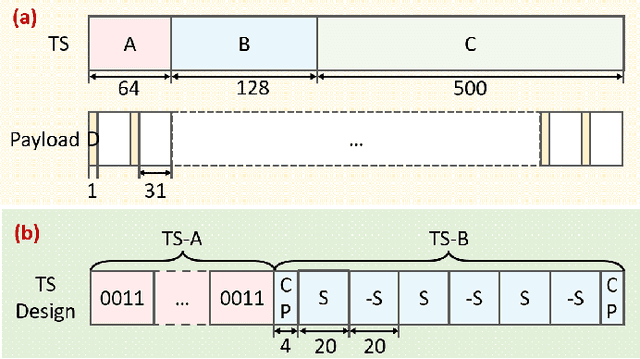
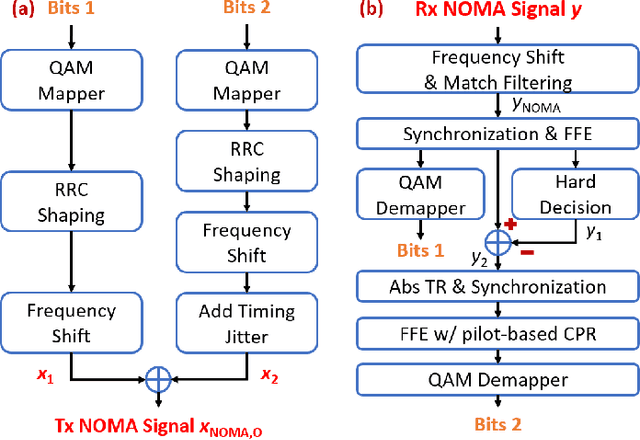
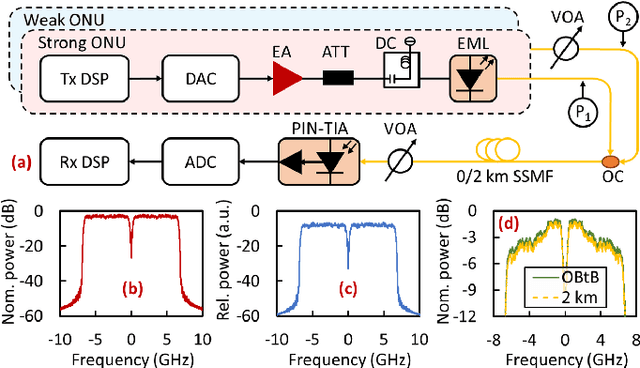
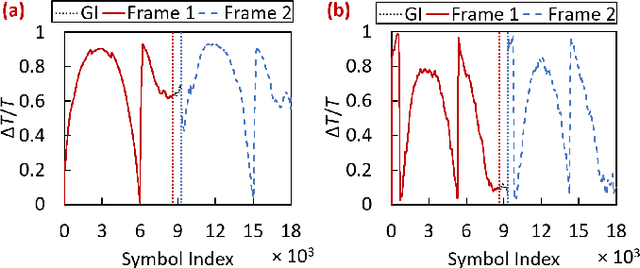
Abstract:A passive optical network (PON) based on non-orthogonal multiple access (NOMA) meets low latency and high capacity. In the NOMA-PON, the asynchronous clock between the strong and weak optical network units (ONUs) causes the timing error and phase noise on the signal of the weak ONU. The theoretical derivation shows that the timing error and phase noise can be independently compensated. In this Letter, we propose a timing recovery (TR) algorithm based on an absolute timing error detector (Abs TED) and a pilot-based carrier phase recovery (CPR) to eliminate the timing error and phase noise separately. An experiment for 25G NOMA-PON is set up to verify the feasibility of the proposed algorithms. The weak ONU can achieve the 20% soft-decision forward error correction limit after compensating for timing error and phase noise. In conclusion, the proposed TR and the pilot-based CPR show great potential for the NOMA-PON.
Pilot-Based Key Distribution and Encryption for Secure Coherent Passive Optical Networks
Nov 05, 2023
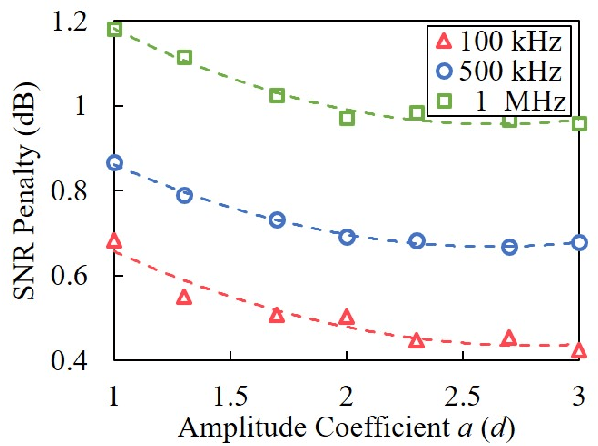
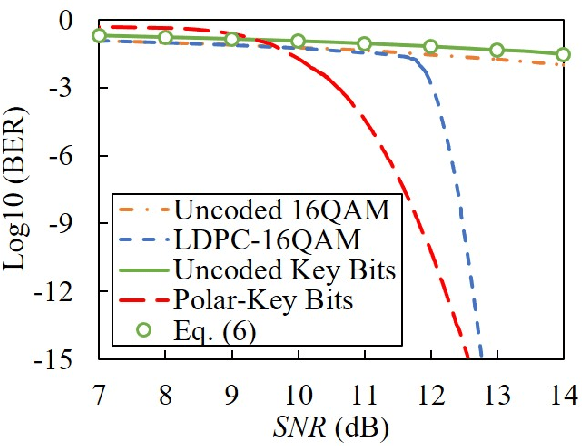
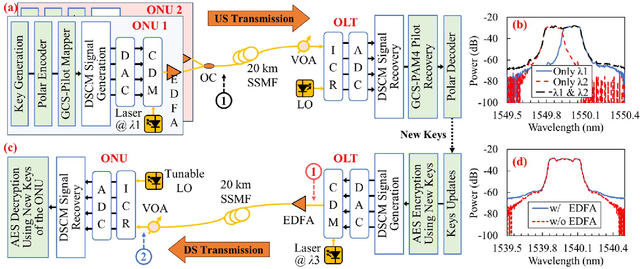
Abstract:The security issues of passive optical networks (PONs) have always been a concern due to broadcast transmission. Physical-layer security enhancement for the coherent PON should be as significant as improving transmission performance. In this paper, we propose the advanced encryption standard (AES) algorithm and geometric constellation shaping four-level pulse amplitude modulation (GCS-PAM4) pilot-based key distribution for secure coherent PON. The first bit of the GCS-PAM4 pilot is used for the hardware-efficient carrier phase recovery (CPR), while the second bit is utilized for key distribution without occupying the additional overhead. The key bits are encoded by the polar code to ensure error-free distribution. Frequent key updates are permitted for every codeword to improve the security of coherent PON. The experimental results of the 200-Gbps secure coherent PON using digital subcarrier multiplexing show that the GCS-PAM4 pilot-based key distribution could be error-free at upstream transmission without occupying the additional overhead and the eavesdropping would be prevented by AES algorithm at downstream transmission. Moreover, there is almost no performance penalty on the CPR using the GCS-PAM4 pilot compared to the binary phase shift keying pilot.
Capacity Limitation and Optimization Strategy for Flexible Point-to-Multi-Point Optical Networks
Oct 19, 2023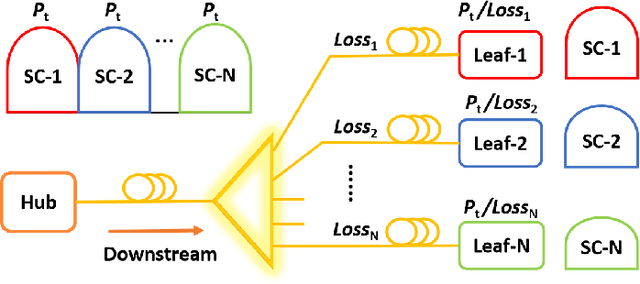
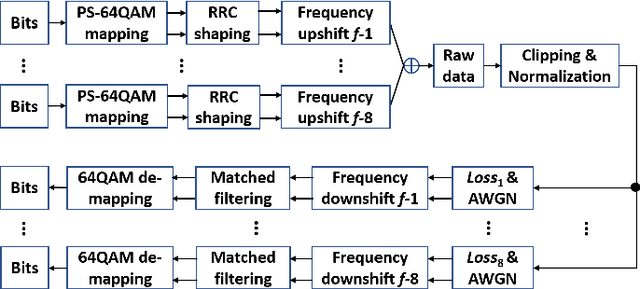
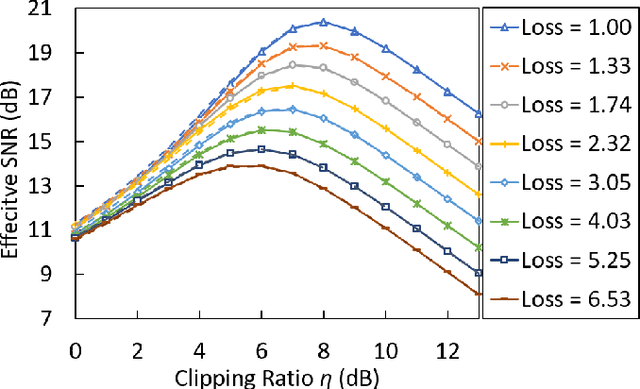
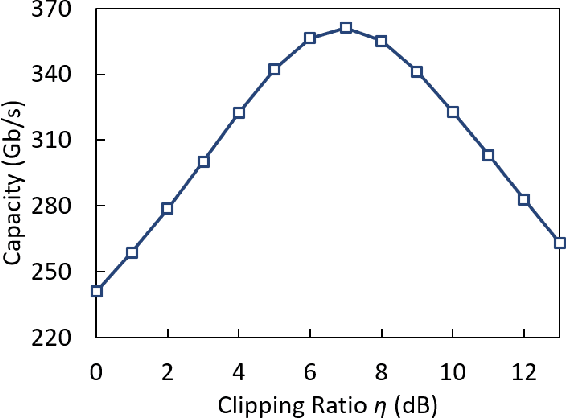
Abstract:Point-to-multi-point (PtMP) optical networks become the main solutions for network-edge applications such as passive optical networks and radio access networks. Entropy-loading digital subcarrier multiplexing (DSCM) is the core technology to achieve low latency and approach high capacity for flexible PtMP optical networks. However, the high peak-to-average power ratio of the entropy-loading DSCM signal limits the power budget and restricts the capacity, which can be reduced effectively by clipping operation. In this paper, we derive the theoretical capacity limitation of the flexible PtMP optical networks based on the entropy-loading DSCM signal. Meanwhile, an optimal clipping ratio for the clipping operation is acquired to approach the highest capacity limitation. Based on an accurate clipping-noise model under the optimal clipping ratio, we establish a three-dimensional look-up table for bit-error ratio, spectral efficiency, and link loss. Based on the three-dimensional look-up table, an optimization strategy is proposed to acquire optimal spectral efficiencies for achieving a higher capacity of the flexible PtMP optical networks.
Non-Integer-Oversampling Digital Signal Processing for Coherent Passive Optical Networks
Jun 20, 2023Abstract:Beyond 100G passive optical networks (PONs) will be required to meet the ever-increasing traffic demand in the future. Coherent optical technologies are the competitive solutions for the future beyond 100G PON but also face challenges such as the high computational complexity of digital signal processing (DSP). A high oversampling rate in coherent optical technologies results in the high computational complexity of DSP. Therefore, DSP running in a non-integer-oversampling below 2 samples-per-symbol (sps) is preferred, which can not only reduce computational complexity but also obviously lower the requirement for the analog-to-digital converter. In this paper, we propose a non-integer-oversampling DSP for meeting the requirements of coherent PON. The proposed DSP working at 9/8-sps and 5/4-sps oversampling rates can be reduced by 44.04% and 40.78% computational complexity compared to that working at the 2-sps oversampling rate, respectively. Moreover, a 400-Gb/s-net-rate coherent PON based on digital subcarrier multiplexing was demonstrated to verify the feasibility of the non-integer-oversampling DSP. There is almost no penalty on the receiver sensitivity when the non-integer-oversampling DSP is adopted. In conclusion, the non-integer-oversampling DSP shows great potential in the future coherent PON.
Timing Recovery for Point-to-Multi-Point Coherent Passive Optical Networks
Apr 11, 2023Abstract:We propose a timing recovery for point-to-multi-point coherent passive optical networks. The results show that the proposed algorithm has low complexity and better robustness against the residual chromatic dispersion.
Multi-Rate Nyquist-SCM for C-Band 100Gbit/s Signal over 50km Dispersion-Uncompensated Link
Jul 25, 2021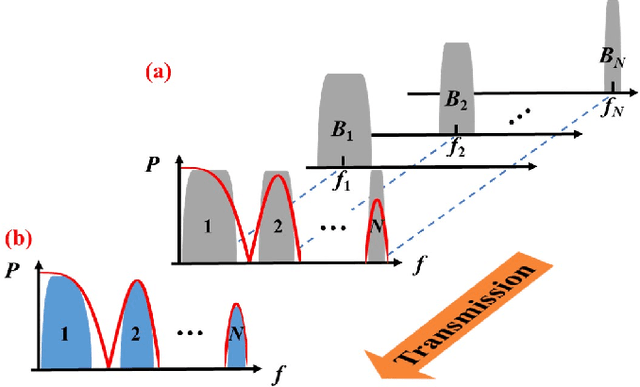

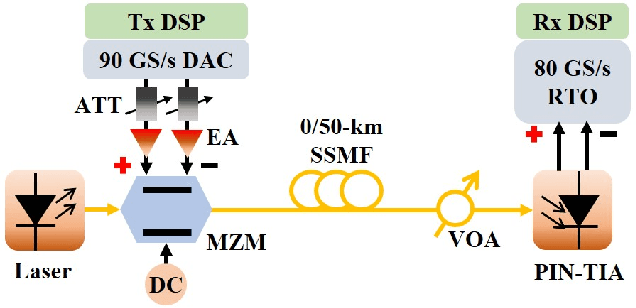
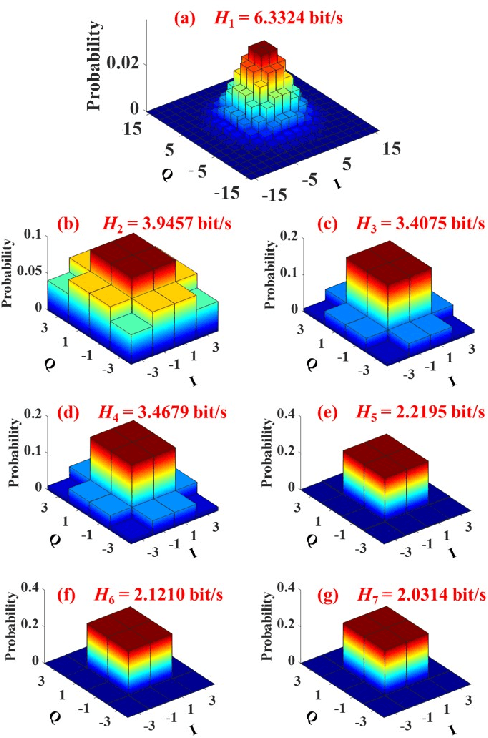
Abstract:In this paper, to the best of our knowledge, we propose the first multi-rate Nyquist-subcarriers modulation (SCM) for C-band 100Gbit/s signal transmission over 50km dispersion-uncompensated link. Chromatic dispersion (CD) introduces severe spectral nulls on optical double-sideband signal, which greatly degrades the performance of intensity-modulation and direct-detection systems. In the previous works, high-complexity digital signal processing (DSP) is required to resist the CD-caused spectral nulls. Based on the characteristics of dispersive channel, Nyquist-SCM with multi-rate subcarriers is proposed to keep away from the CD-caused spectral nulls flexibly. Signal on each subcarrier can be individually recovered by a DSP with an acceptable complexity, including the feed-forward equalizer with no more than 31 taps, a two-tap post filter, and maximum likelihood sequence estimation with one memory length. Combining with entropy loading based on probabilistic constellation shaping to maximize the capacity-reach, the C-band 100Gbit/s multi-rate Nyquist-SCM signal over 50km dispersion-uncompensated link can achieve 7% hard-decision forward error correction limit and average normalized generalized mutual information of 0.967. In conclusion, the multi-rate Nyquist-SCM shows great potentials in solving the CD-caused spectral distortions.
A New Channel Estimation Strategy in Intelligent Reflecting Surface Assisted Networks
Jun 22, 2021



Abstract:Channel estimation is the main hurdle to reaping the benefits promised by the intelligent reflecting surface (IRS), due to its absence of ability to transmit/receive pilot signals as well as the huge number of channel coefficients associated with its reflecting elements. Recently, a breakthrough was made in reducing the channel estimation overhead by revealing that the IRS-BS (base station) channels are common in the cascaded user-IRS-BS channels of all the users, and if the cascaded channel of one typical user is estimated, the other users' cascaded channels can be estimated very quickly based on their correlation with the typical user's channel \cite{b5}. One limitation of this strategy, however, is the waste of user energy, because many users need to keep silent when the typical user's channel is estimated. In this paper, we reveal another correlation hidden in the cascaded user-IRS-BS channels by observing that the user-IRS channel is common in all the cascaded channels from users to each BS antenna as well. Building upon this finding, we propose a novel two-phase channel estimation protocol in the uplink communication. Specifically, in Phase I, the correlation coefficients between the channels of a typical BS antenna and those of the other antennas are estimated; while in Phase II, the cascaded channel of the typical antenna is estimated. In particular, all the users can transmit throughput Phase I and Phase II. Under this strategy, it is theoretically shown that the minimum number of time instants required for perfect channel estimation is the same as that of the aforementioned strategy in the ideal case without BS noise. Then, in the case with BS noise, we show by simulation that the channel estimation error of our proposed scheme is significantly reduced thanks to the full exploitation of the user energy.
 Add to Chrome
Add to Chrome Add to Firefox
Add to Firefox Add to Edge
Add to Edge